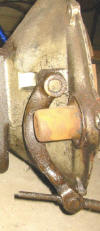
Clutch
Click on blue lined pictures for enlargement
The clutch of an early VA (pre engine num,ber TPBG 1510) as well as all SA clutches are running in engine oil.
They are easily identified if you look under your car. If the clutch operating shaft is above the centerline of the clutch belhousing and the operating lever is bent as on the left photo your VA has a wet clutch.
If the operating shaft is under the bellhousing centre line and the operating lever is short and straight as on the right picture your VA is equipped with a dry clutch.
The friction material of a wet clutch plate is originally cork and not difficult to replace. Although these "wet"clutches tend to stick a bit when cold they perform very well and give a smooth operation.
New corks should stick out 3,5 mm when new.
One important drawback is the fairly complex and time consuming construction if repair is needed.
Kevlar lined plate on the left
Genuine cork lined plate on the right
Also when during its life particles of the cork start letting loose they are not always caught by the simple pre war oil filter. These particals may end up blocking the vital oilways in the crankshaft holding back sufficient lubrication of the big end bearings.
A modern day solution is now the fitting of a Kevlar lining to the old plate. It is glued in place and will stand temperatures up to 750 degrees Celcius. Costing about € 100. Make sure the Kevlar is grooved as in the photo, so the oil can escape.
One brand of these modern linings is "New 53 Langite" which is in fact a cork neoprene composite, manufactured by Ferodo and available through the old payen Gasket Company, part of Federal Mogul.
Always when working on these wet clutches do replace the tension coil springs by new (uprated) ones.
This is the right set up of the release trust bearing and clutch fork for a wet clutch. There is only pressure on the bearing when you press the clutch pedal against the pressure of the clutch springs. Make sure the bearing is fitted the right way round !
For the dry clutch VA's replacement parts are easily available in every automotive parts shop. Its a simple Borg & Beck 8 inch clutch, as in many old British cars, like the Austin Cambridge etc. Partnumber of release bearing L 528. Partnumber Cover Assembly 3 D 02530. Clutch plate partnumber DN 47625/35.
Extremely important with dry clutches is to make sure that the clutch operating rod is adjusted in such a way that there is some 2-3 mm play before the clutch release bearing is activated. Also never drive these clutches with your foot on the pedal. If you do so, or if too tightly adjusted the coal ring in the bearing will wear out very quick.